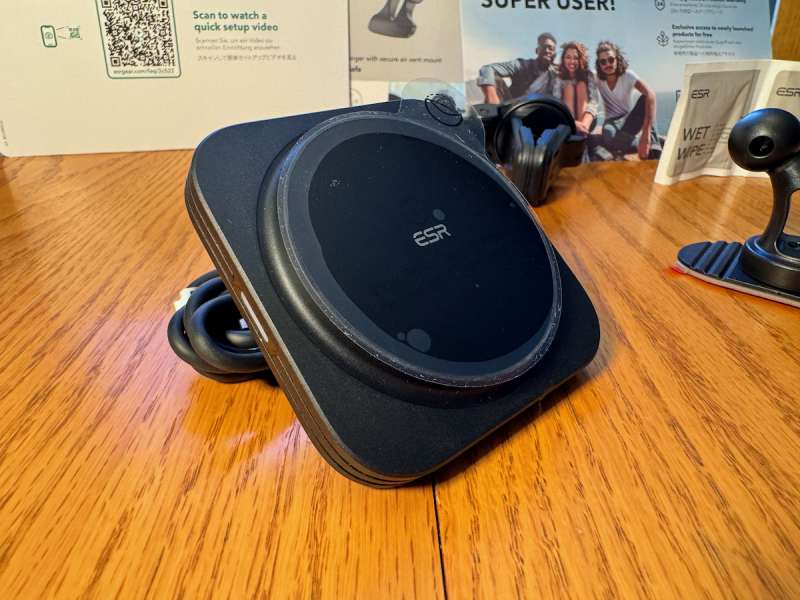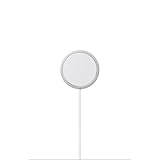REVIEW – Having a phone mounted in the car is a must for many people. If you commute a lot or travel for work, keeping a phone mounted nearby is a must. Keeping the phone charged is necessary as well, so it can get you where you’re going without dying or being low on battery the rest of the day. There are many choices in car mounts and charging solutions out there so how do you choose? ESR has a neat solution in their new Qi2 Halolock MagSafe wireless car charger.
What is it?
The ESR Qi2 Halolock is a MagSafe compatible wireless car charger designed to mount your phone in a car and keep it charged safely while driving.
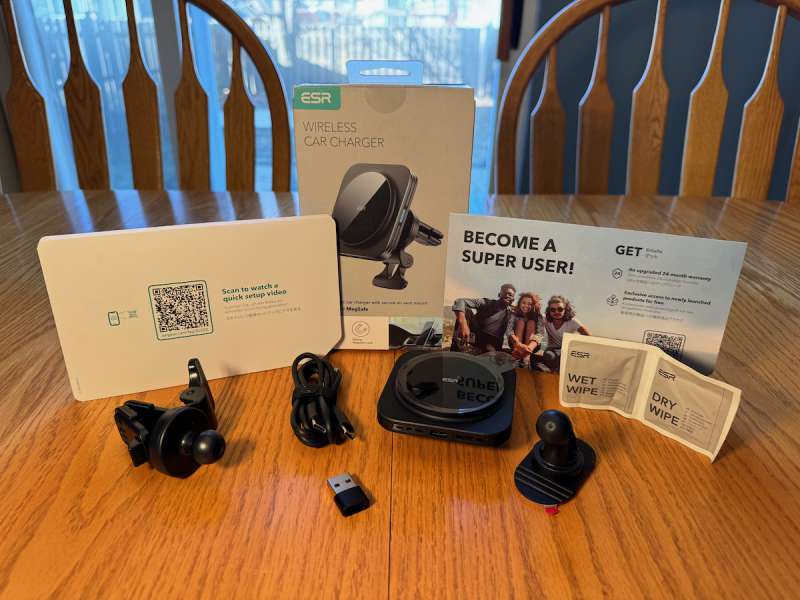
What’s included?
- ESR Qi2 Halolock MagSafe wireless car charger
- Air Vent Mount
- Dashboard Anchor
- 3-ft (1 m) USB-C to USB-C Cable
- USB-C to USB-A Adapter
- Cleaning Kit
- Manual
Tech specs
Click to expand
Input: 9V= 2.2A, 12V = 1.67A
Output: 15W/7.5W/5W
Size: 3.15 x 3.15 x 1.26 in (80 x 80 x 32 mm)
Weight: 5.5 oz (156 g)
Magnetic Strength: 1,400 gf
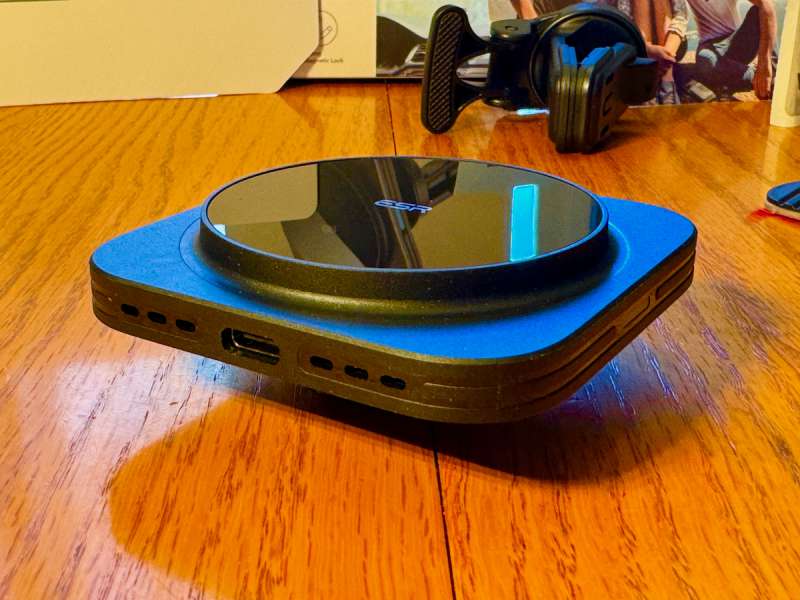
Design and features
The ESR Qi2 Halolock MagSafe wireless car charger is, essentially, a small, black, square puck with a circular magnetic charger sticking out of the front, and a small threaded adapter sticking out of the back. The threaded adapter can be attached to a vent mount clip or a dashboard anchor (both included). On the top and bottom sides of the charger are air vents and the bottom side has a USB-C port for voltage input. The left and right sides have a status LED which indicates several different states: the LEDs turn on for 5 seconds when the charger is first plugged in but not charging a phone; the LEDs stay lit while charging a phone; the LEDs flash if there’s an error detected. There isn’t any indication of whether there is a fan built in or not, but if there is it doesn’t make any noise (not perceptible over road noise anyway).
The charger comes with two mounting options – air vent and dashboard. The charger attaches to both with a ball mount, which is tightened by a square plastic nut. The air vent works both horizontally and vertically. With the dashboard mount you can rotate the charger to whichever direction you need it to face for the driver’s best view of the attached phone. The vent mount clip has an adjustable leg that allows the charger to rest on the vent or dash below, providing extra stability to the setup. Whichever mounting option you choose, the phone can be rotated 360º to accommodate any orientation you want.
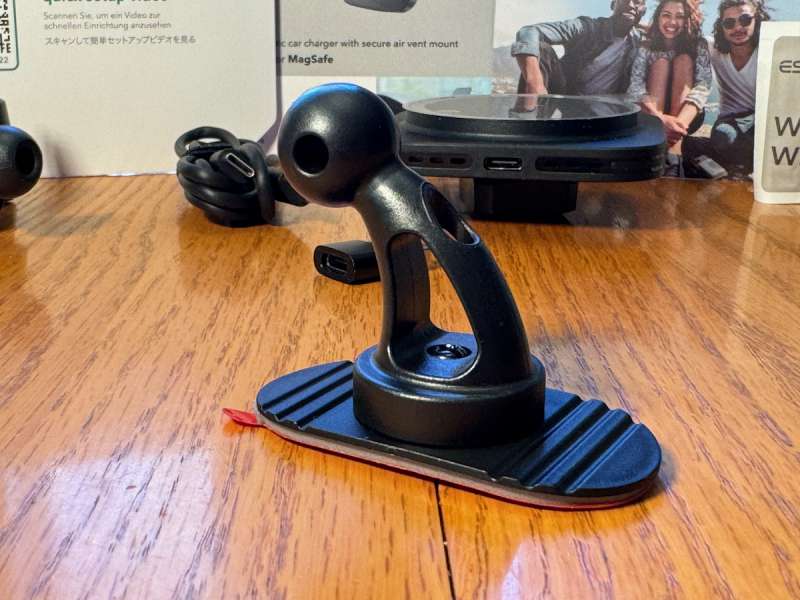
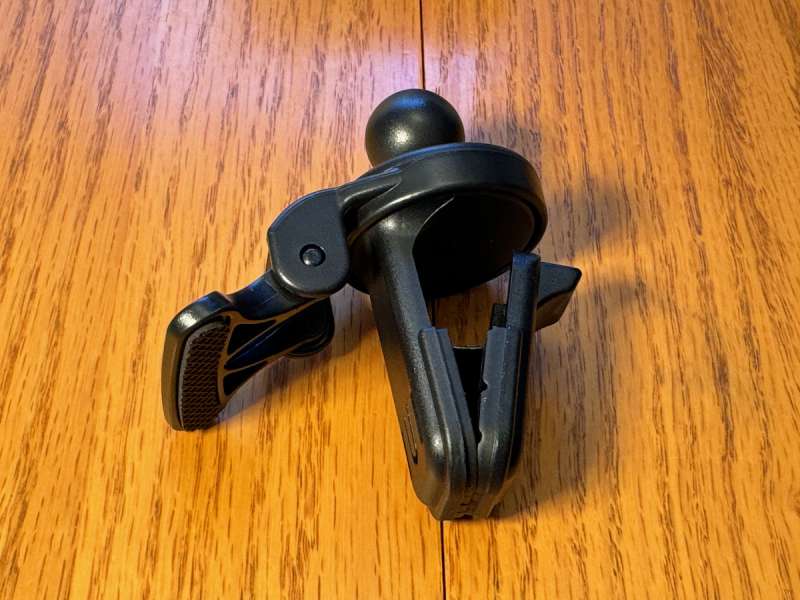
The package also includes a 3 foot USB-C to USB-C cable, which is plenty long to get to the power outlets in most cars. A USB-A to USB-C adapter is also included. One thing to note is that ESR says that 15W charging output is attainable only when using a USB-C to USB-C cable, not with the included USB-A adapter (or, presumably, a USB-A to USB-C cable). This is due to the fact that to get the 20W necessary to fully charge a phone at 15W, you have to use a PD-compatible charger, which is based on USB-C.
The magnets that hold the phone are sufficiently strong. ESR says the strength of the magnets is 1,400 gf. I’m not a scientist so I don’t know much about magnetic strength, but in my testing it was plenty to hold the phone stable while driving over all the bumps I’ve come across on the roads around me. ESR says the dashboard anchor can support up to 48 lb., which should be sufficient for any phone available. This mount comes with a strip of 3M VHB tape already attached to the bottom so this is likely how they’re able to support so much weight.
There is no cigarette lighter/power outlet adapter included in the package I received. It’s important to have a PD-capable charger to get enough wattage transferred to the phone. More on this later in the review.

This mount is designed to work directly with iPhones that support Qi charging and MagSafe. For other phones that are Qi compatible but don’t have the MagSafe magnets built-in, ESR sells a Universal Ring (HaloLock) kit that puts a ferromagnetic ring on the back of the case and they even include a guide to help mount it in the proper location for the phone you’re using it with.
Assembly, Installation, Setup
After taking the parts out of the box, you need to choose whether you want to use the air vent clip or the dashboard anchor. Once chosen, slide the square plastic nut over the ball mount, push the ball mount into the opening in the back of the charger, then tighten the nut to the charger. If you choose to go with the dashboard anchor, you’ll probably want to mount it to the dash first (after using the included wipes to clean the dash), then mount the charger, just to make it easier to work with. Then, using the included cable (and the USB-A adapter if necessary), plug the cable into your car’s built-in USB port, or the USB port on a separate 12V car outlet charger. After this, all you need to do is rotate the charger to face the driver and attach the phone to the charger.
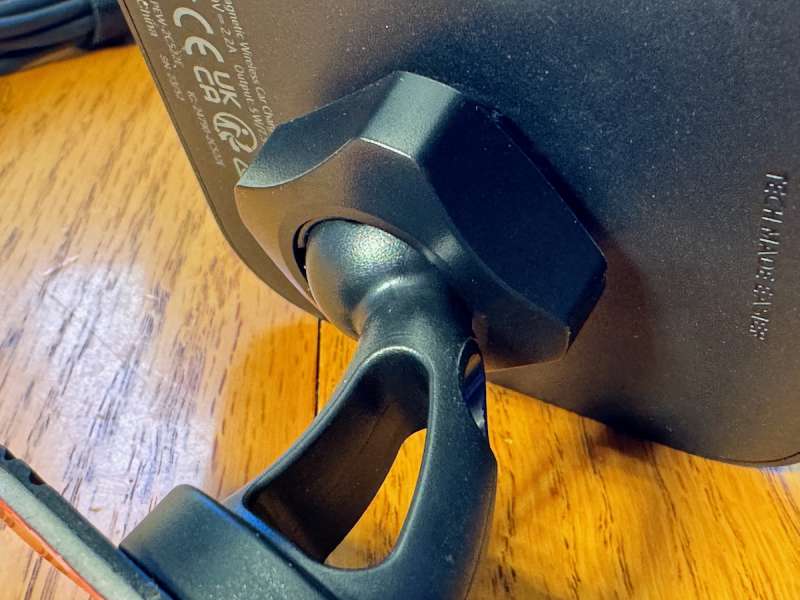
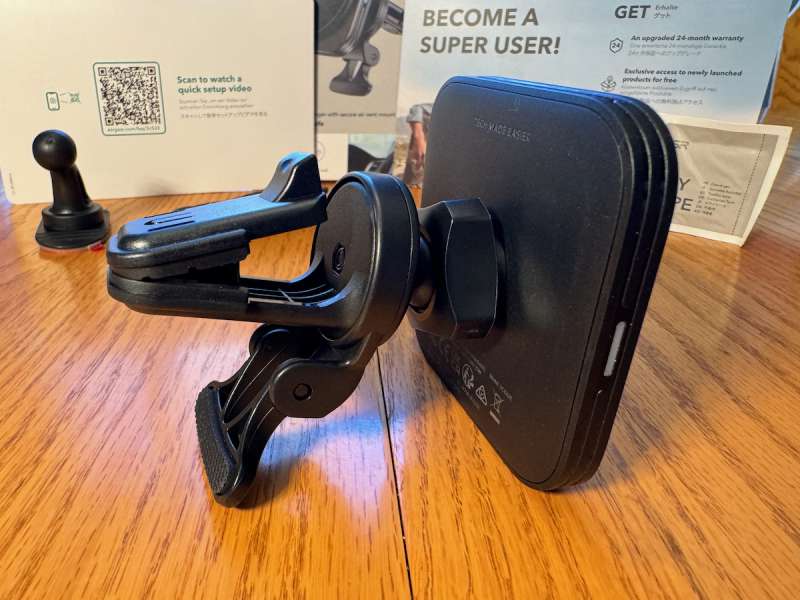
In Use
I did most of my testing of the ESR Qi2 Halolock MagSafe wireless car charger with the air vent clip attached to a vertical vent. I will admit I’ve never been a fan of air vent mounts. You see a lot of them on Amazon and other resellers. They’re convenient because you don’t have to mount anything to the dash but keeping them in place, or finding the perfect spot for them is tricky. They also block the air vents – not bad in the winter but during hot summer months, they can block most or all of the air coming out of that vent. I did all my testing in Illinois in February, and except for one day where it got to 75º, there has been no need for AC. When the summer months come, though, I’m not going to want anything blocking my air vents. This is not a knock against ESR or this charger, it’s just my preference. Plenty of people use these and are happy with them. I’m happy that I have both mounting options (and a third that I’ll explain later).
In my testing with the air vent mount, though, I never had a problem with the clip or charger staying in place. The clip is so tight that I found it kind of difficult to put on the air vent, but when it was clipped on, it never moved that I could tell. Because my car has vertical vents, though, when I would go around a corner, the phone would sway from side to side a little bit. It wasn’t enough to cause me not to be able to see the phone, and never fell off or slipped, but it wasn’t as stable as I would have liked. Again, this is due to the vent mounts in my car, not a problem with the vent mount itself.
I never tested this with the included dashboard anchor, however, mostly due to not wanting to permanently attach something to my dash that I wasn’t 100% sure I wanted there. Because the included 3M VHB tape creates a bond with whatever it’s attached to, I didn’t want to destroy my dash or the mount by trying to remove it if I didn’t want to use it.
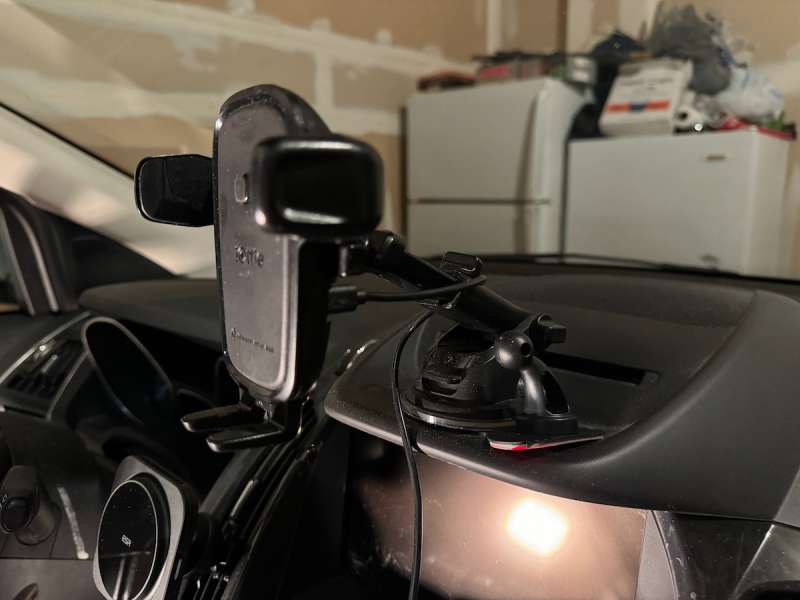
The reason I didn’t use the included anchor was that I wanted to do an experiment, which turned out to work perfectly for my setup. I’ve used a dashboard phone mount for several years in my car, which includes a ball mount similar to the one the ESR charger uses. I checked to see if it would fit and it did. Since I already had this essentially permanently mounted to my dashboard I didn’t want to give it up. I’ve used this for several days during the review period and it’s as stable as with the vent mount but without the side-to-side swaying that I experienced. I don’t necessarily recommend going out and buying this type of dashboard mount just so you can do it the way I did, but since I already had it I wanted to see if it would work and it did. This mount includes a telescoping arm, which puts the charge closer to the driver, which is something I really liked about it. ESR sells a similar mount to this with a magnetic mount so you don’t have to put together two mounts to accomplish what I’ve done, although I don’t believe it’s Qi2 or 15W capable with the newest iPhones. Perhaps they’ll upgrade that mount in the near future.
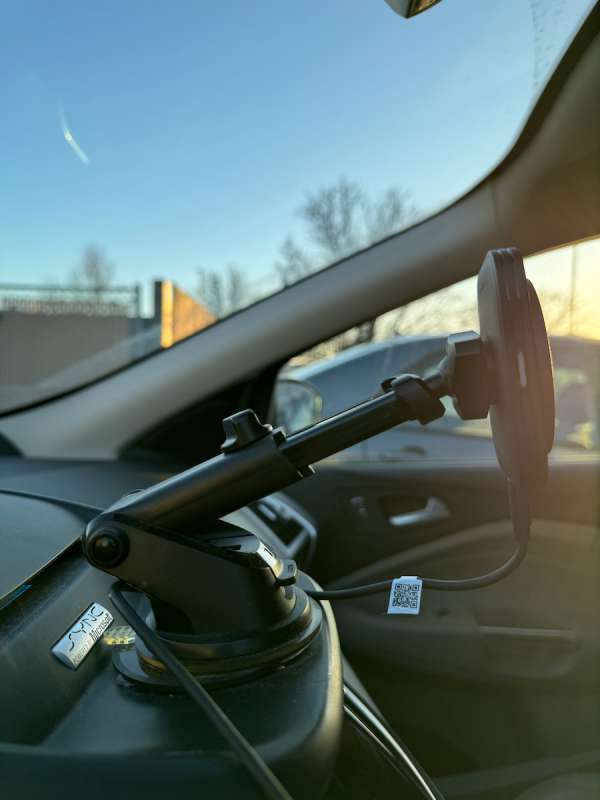
Along with my old phone mount I had an old plug in charger that I’ve been using for a while. It has two USB-A ports on in, which are capable of putting out up to 2.4A of current. At 5V for a phone, that’s only 12W, however. Without even factoring in the wattage lost due to wireless charging, that’s clearly not enough to charge a phone at 15W. I decided to try it anyway, and I was never able to get any faster charging speed than I did with the old mount, which used the original Qi standard, which only supports 7.5W for an iPhone. Since the ESR charger is capable of charging at 15W, I didn’t want to restrict it due to an old charger, so I purchased a charger that outputs up to 30W on one USB-C port and 100W on the other. In testing, both of these outputs were enough to charge the phone at full speed.
For testing the speed of charge I used a few different methods: 1. Included USB-C cable with USB-A adapter, plugged directly into the phone and the older USB-A only charging plug, 2. Included USB-C cable with USB-A adapter, plugged into old, Qi-compatible charger and the older USB-A only charging plug, 3. Included USB-C cable with USB-A adapter, plugged in to the ESR charger and the older USB-A only charging plug, 4. Included USB-C cable with new USB-C PD-capable charger, plugged in to the ESR charger. I also did some testing with the case on and off. I won’t put every result here or this review would be too long; instead I’ll highlight the differences that stand out. All of these tests were done during my commute home from work, which is typically about 35-40 minutes. During my commute I had my maps app running (yes, I do know how to get home but I like the updates on traffic or options for faster routes that the maps app gives me, plus it’s just fun to see a live map of where I’m going) and I was also playing podcasts and taking the occasional phone call using a bluetooth headset. I would expect the charging % to go up if I didn’t have the GPS running and the screen on the whole time, but that’s how I usually drive so that’s how I tested it.
Every charging method I used with the old USB-A only charger resulted in about 8-15% additional charge, whether the phone had the cable plugged in directly, using the old Qi mount, or the new ESR Qi2/MagSafe compatible charger. I attribute this to the old USB-A charger not being able to put out enough current for fast charging.
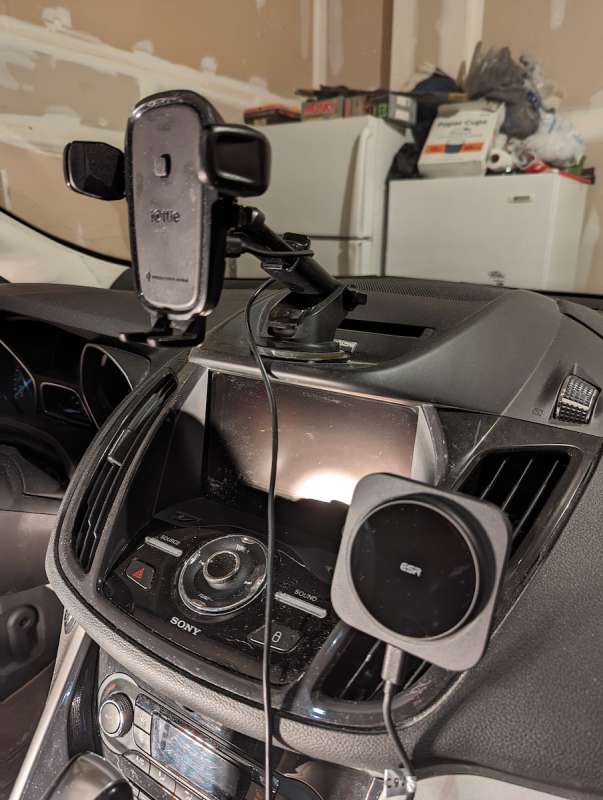
Once I purchased the 130W capable charger, the percentage of charge over the same commute time went up, as I expected. I saw 23%-29% charge increase from the starting point of each drive home. That’s 2-3 times as much charge as with the older charging methods. That’s enough to keep the phone topped up on a long drive or at least give it a nice boost if you’re not going very far. I did encounter one weird charging result the first time I tried with the new PD-capable plug and the ESR charger. It only increased by 14% over the whole drive, which was about the same as before. I would check the % periodically and it hadn’t increased from its initial charge level for a while. About 10 minutes into the drive home I removed the phone from the charger and put it back on. Within a few minutes I noticed that the charge was increasing as expected, but since almost 1/3 of the drive home was gone there wasn’t enough time to increase the charge level as much as it should have. I haven’t encountered this since that first time so that’s encouraging.
One thing I really like about the ESR Qi2 Halolock MagSafe wireless car charger is that it’s so easy to place and remove the phone and I don’t have to wonder whether it’s lined up correctly with the charger, like I would with an older Qi/non-MagSafe charging solution. Another thing I really like is that there aren’t “wings” on the side of the phone or “feet” at the bottom that get in the way of normal phone operations. I don’t condone using a phone while driving, which is part of the reason I’ve had my phone in a mount for so many years, but if you have to swipe to answer a call, or tap the skip button to go to a new track, it’s nice to not have those things in the way of touching the screen, especially at the edges.
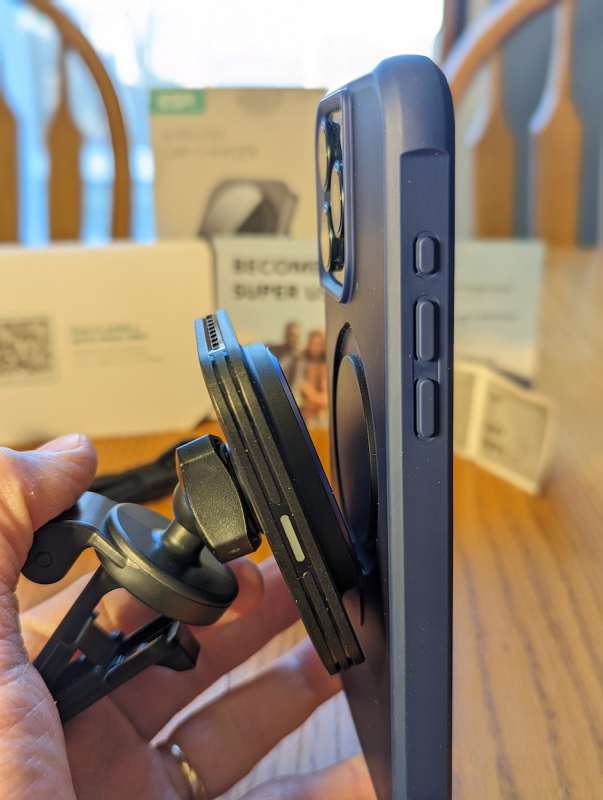

I did do a quick magnetic test with my Google Pixel 6 phone to see if the ESR charger would hold it up. It was able to hold it up well enough for me to take a picture but when I tried to attach it to the charger in the car it slid off immediately. Since this isn’t a primary phone for me I’m not going to buy the Universal Ring kit, but it’s nice to know that’s an option if I ever want to do it.
What I like about the ESR for 15W MagSafe Car Mount Charger
- Strong magnetic grip
- Easy to place phone on and lift it off of the charger
- Vent mount grips very tightly
- Includes both vent mount and dashboard anchor options
What needs to be improved?
- Include a USB-C PD-capable charger (or sell as an optional package)
Final thoughts
The ESR Qi2 Halolock MagSafe wireless car charger lived up to my expectations, once I purchased a new PD-capable power plug to go with it. Construction is solid, it’s easy to use, and I was able to use it with my existing mount, making it even more useful for my setup.
Price: $39.99
Where to buy: amazon.com or esrgear.com
Source: The sample of this product was provided for free by ESR. ESR did not have a final say on the review and did not preview the review before it was published.

